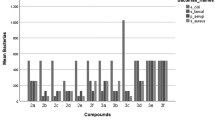Abstract
A series of 6-[N-(halophenyl)amino]-7-chloro-5,8-quinolinedione derivatives 1–10 were tested for antifungal susceptibilities,in vitro, against pathogenicCandida species such asC. albicans, C. glabrata, C. krusei, C. parapsilosis andC. tropicalis. The MICs were determined by the standard macrodilution techniques, according to the NCCLS 1992 guidelines. The 6-[N-(halophenyl)amino]-7-chloro-5,8-quinolinedione derivatives showed generally potent antifungal activities against pathogenicCandida species. Among them, derivative1, 2, 5 and7 showed more potent antifungal activities than ketoconazole. All derivatives1–10 had specially potent activities againstC. tropicalis. Derivative1 and2 containing (N-3,4-dihalo-phenyl)amino moiety exhibited the potent antifungal activities. Derivative2 with (3,4-dichlorophenyl)amino substituent was the most effective in preventing the growth ofCandida species at MICs 4 μg/ml respectively.
Similar content being viewed by others
References Cited
Bowman, C. M., Porter, T. H., Skelton, F. S. and Folkers, K., 5,8-Quinolinequinone analogs which inhibit mitocondrial succinoxidase.J. Med. Chem., 14, 206–209 (1973).
Cadenas, E. and Ernster, L., Effect of superoxide dismutase on the autoxidation of hydroquinones formed during DT-diaphorase catalysis and glutathione nucleophilic addition: Emerit, I., Packer, L. and Auclair, C. (Eds.),Antioxidants in therapy and preventive medicine-Advances in experimental medicine and biology, Vol. 264, Plenum, New York, 1990, pp. 37–44.
Dupouy-Camet, J., Paugam, A. and Tourte-Schaefer, C., Yeast susceptibility testing.Lancet, 338, 383 (1991).
Espinel-Ingroff, A., Kish, Jr. C. W., Kerkering, T. M., Fromtling, R. A., Bartizal, K., Galgiani, J. N., Villareal, K., Pfaller, M. A., Gerarden, T. M., Rinaldi, G. and Fothergill, A., Collaborative comparison of broth macrodilution and microdilution antifungal susceptibility tests.J. Clin. Microbiol., 30, 3138–3145 (1992).
Espinel-Ingroff, A., Kerkering, T. M., Goldson, P. R. and Shadmy, S., Comparision study of broth macrodilution and microdilution antifungal susceptibility tests.J. Clin. Microbiol., 29(6), 1089–1094 (1991).
Galgiani, J. N., Rinaldi, M. G., Polak, A. M. and Pfaller, M. A., Standardization of antifungal susceptibility testing.J. Med. Vet. Mycol., 30 (Suppl. 1), 213–224 (1992).
Hafuri, Y., Takemori, E., Oogose, K., Inouye, Y. and Nakamura, S., Mechanism of inhibition of reverse transcriptase by quinone antibiotics.J. Antibiotics, 41, 1471–1478 (1988).
Inouye, Y., Take, Y., Keiko, O., Kobo, A. and Nakamura, S., The quinolinequione as the minimum entity for reverse transcriptase-inhibitory activity of streptonigrin.J. Antibiotics, 40, 105–109 (1987).
Mcginnis, M. R. and Rindali, M. G., Antifungal drug: Lorian, V. (Eds.),Antibiotics in laboratory medicine, 3rd ed., Williams and Wilkins, Baltimore, 1991, pp. 198–256.
NCCLS; National Committee for Clinical Laboratory Standards, 1992.Reference method for broth dilution antifungal susceptibility testing of yeasts. Proposed standard. Document M27-P. National Committee for Clinical Laboratory Standards, Villanova, Pa. USA (1992).
Oyanagui, Y. (Eds.),SOD and active oxygen modulators-pharmacology and clinical trials, Nihon-Igakukan, Tokyo, Japan, 1989, pp. 389, 618, 670.
Pfaller, M. A., Burmeister, L., Bartlett, M. S. and Rinaldi, M. G., Multicenter evaluation of four methods of yeast inoculum preparation.J. Clin. Microbiol., 26, 1437–1441 (1988).
Porter, T. H., Skelton, F. S. and Folkers, K., Synthesis of 5,8-quinolinequinones as inhibitors of coenzyme Q and antimalarials.J. Med. Chem., 14, 1029–1033 (1971).
Rex, J. H., Pfaller, M. A., Rinaldi, M. G., Polak, A. and Galgiani, J. N., Antifungal susceptibility testing.Clin. Microbiol. Rev., 6, 367–381 (1993).
Roberts, H., Choo, W. M., Smith, S. C., Marzuki, S., Linnane, A. W., Porter, T. H. and Folkers, K., The site of inhibition of mitochondrial electron transfer by coenzyme Q analogs.Arch. Biochem. Biophys., 191, 306–315 (1978).
Ryu, C. K. and Kim, H. J., The synthesis of 6-(N-arylamino)-7-chloro-5,8-quinolinedione derivatives for evaluation of antifungal activities.Arch. Pharm. Res., 17(3), 139–144 (1994).
Sheehan, D. J., Espinel-Ingroff, A., Moor, D. J. and Webb, C. D., Antifungal susceptibility tests of yeasts: A brief overview.Clin. Infec. Diseases, 17 (Suppl. 2), 494–500 (1993).
Wagner, A., Beck, W. and Diskus, A., Fungicides, Austrian patent, 220, 425–426 (1962);Chem. Abstract; 57, 3420, 9823, 11160 (1962); 56, 4740 (1962).
Yasuda, M. and Boger, D. L., Streptonigrin and lavandamycin partial structure. A probe for the minimum potent pharmacophore of the antitumor anitibiotics.J. Heterocycl. Chem., 24, 1253–1260 (1987).
Author information
Authors and Affiliations
Rights and permissions
About this article
Cite this article
Ryu, CK., Kim, DH. The antifungal activities of some 6-[N-(halophenyl)amino]-7-chloro-5,8-quinolinediones againstCandida species. Arch. Pharm. Res. 17, 483–486 (1994). https://doi.org/10.1007/BF02979131
Received:
Issue Date:
DOI: https://doi.org/10.1007/BF02979131




